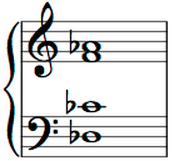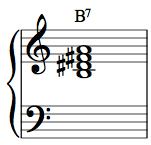MUSIC THEORY QUIZ

Wouldn’t it be fun to go back to school? Recess, lunch with friends, quizzes… Yeah, quizzes. Sounds like fun, right? I was recently putting together a music theory quiz for a new lesson and thought to myself, “I should share this with all of our students out there who are music theory fans.” (I don’t lead the most exciting life).
Take the quiz, check your answers, tally your score, and discover how much of a music geek you are by getting your ranking below. No cheating (this means no internet assistance!) The questions get progressively more challenging.
#1. Which two keys are indicated by this key signature?
#2. Identify this interval?
#3. Name the scale (mode) written below.
#4. Identify the chord below. (Identify the root and quality of the chord - ie, the root of the chord and whether it is major, minor, dominant, etc).
#5. Using Roman numeral analysis, identify (label) the chord progression below.
#6. Using Roman numeral analysis, identify (label) the 4-measure passage below.
#7. Spell a C#m7 chord in 1st inversion.
#8. Rewrite the closed-position F7 chord below in open-position.
#9. Write an Eb harmonic minor scale.
#10. What is a V7/V chord in the key of A major?
Now check your answers, tally up your score, and see where you rank below. Correct answers are 1 point apiece, no partial credit allowed. (It’s all or nothin’ folks).
RANKINGS
0 points = “Dunce Cap”
1-3 points = “Stay After School For Extra Help”
4-5 points = “Shows Potential”
6-7 points = “A Pleasure to Have in Class”
8-9 points = “Teacher’s Pet”
10 points = “Valedictorian and a Gold Star!”
ANSWERS:
#1. A major and F# minor
#2. Minor 6th
#3. C phrygian (3rd degree of an Ab major scale)
#4. Db7 (i.e., D-flat dominant 7th chord)
#5. “ii - V7 - I” progression in the key of G major (ie, Am, D7, Gmaj)
#6. In key of E major: m1 = Emaj (I); m2 = B7 (V7); m3 = Amaj (IV) and Emaj (I); m4 = B7 (V7) and Emaj (I)
#7. Can be written anywhere on staff (treble or bass) but must read in this order (from bottom up): E, G#, B, C#. Example answer:
#8. Answers will vary. Chord must be spread across a range larger than an octave (i.e., an “open-position” or “spread” voicing). Example answer:
#9. Eb, F, Gb, Ab, Bb, Cb, D, Eb
#10. “B7” chord













